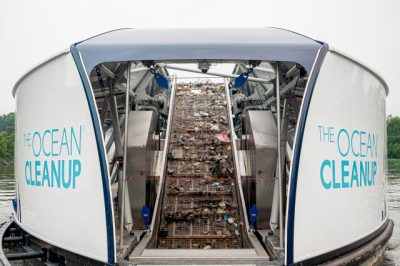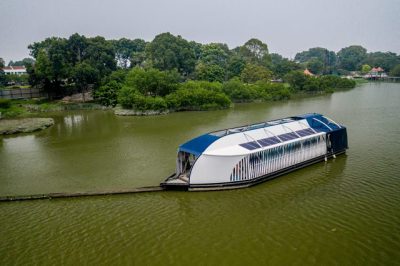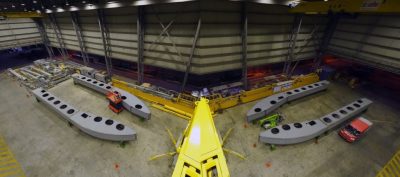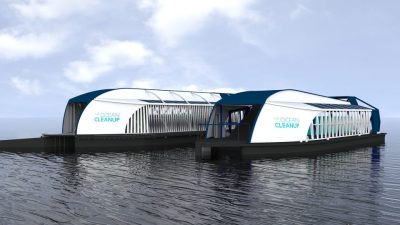
The Great Pacific Garbage Patch is just one of a number of pollution disasters affecting the world’s oceans. All over the globe, huge amounts of plastic enter waterways every day, causing havoc in delicate ecosystems.
Heading up the charge to deal with the problem, The Ocean Cleanup have been working on a variety of projects to help clean up plastic pollution. Chief among these is their river cleanup efforts, aiming to stop plastic pollution from reaching the ocean in the first place. The non-profit group intends to rapidly scale up its efforts, partnering with Finnish industrial manufacturer Konecranes in order to put its latest river cleaning design into series production.
We last reported on the group’s efforts in 2020, with their Interceptor craft operating in rivers in Malaysia, Indonesia, and the Dominican Republic. They’ve since refined the design for better functionality and easier deployment. Let’s jump in and see what they’ve learned and how their hunt for plastic pollution is shaping up.
A Gargantuan Task

The Ocean Cleanup was founded in 2013, aiming to find a solution to clean up plastic pollution in the open ocean. However, in years, since the group’s focus has shifted to other areas as well, as modelling has shown that stemming plastic flows from the world’s rivers can be more effective than capturing it once it’s in the ocean itself.

Much focus has been placed on correctly identifying the greatest sources of plastic pollution, in order to best focus the cleanup where it can make the biggest difference. The latest research dives deep into the causal factors behind plastic outflows, and further reinforces previous studies that suggest up to 80% of ocean plastic flows out of just 1,000 rivers worldwide. Populated areas close to rivers or oceans, particularly those with poor waste management practices, are the most likely to produce large amounts of plastic pollution that finds its way to the ocean. Other factors, such as rainfall and terrain elevation can also play a role in where discarded plastic ends up.
Taking Things Up A Notch
The Ocean Cleanup has taken the lessons learned from its first four river-based Interceptor craft, which autonomously collect plastic waste from rivers before it can flow out to the ocean. This knowledge has led to the development of the upgraded third-generation Interceptor, which aims to work more efficiently than its predecessors. The new design mounts a bigger conveyor belt and larger dumpsters to process larger amounts of trash with less blockages. It’s also been redesigned with an eye to containerization, allowing Interceptors to be more readily shipped around the world and deployed more easily.

Two of the new Interceptors are being manufactured in Konecranes’ MHE-Demag facility in Malaysia for future deployment, with a further craft designated for Los Angeles later this year. It’s intended for the Finnish company to run production and servicing for the Interceptor craft going forward, drawing on their industrial machinery experience to build and maintain the fleet in the most efficient manner possible. Mainstream rock band Coldplay have also jumped on board, sponsoring the build of Interceptor-005, with the band citing their passionate support of the project.

In an interview with CNET, CEO Boyan Slat highlighted that the first two Interceptors built with Konecranes will be used to validate the operational model, while not providing a clear timetable for full series production. The company has committed to production of ten Interceptors at this stage. The upgrades will be key to the success of the project, with Slat stating “We’ve found that we can still further reduce the cost, the ease of rollout and the ease of assembly to really speed up the deployment as much as possible while also making it more efficient.” He goes on to say “We found [the previous Interceptor] often would clog when it comes to very large debris. So widening that will help also improve the reliability of the operation.”
Today the Rivers, Tomorrow the Ocean
The organisation hasn’t forgotten about the ocean either, with the group set to deploy System 002 in 2021 – the latest iteration of its ocean-scouring rig. It aims to solve some of the operational issues with earlier designs of the group’s original headline project, which struggled to effectively collect large amounts of garbage in early deployments. As an aside to the project, The Ocean Cleanup also produced a run of sunglasses produced with the plastic harvested in early missions. However, the effort was more of an aid to promote the group’s work rather than a major push towards commercialization. “We don’t plan to become a products organisation; our focus is to clean the oceans,” said Slat.
With a thousand rivers and the entire Great Pacific Garbage Patch on the organisation’s target list, obviously a huge amount of funding will be required to produce enough Interceptors to do the job, as well as a monumental effort to work with local governments on the red tape prior to deployment. The basic concept remains a good one, and the hardware better than ever, but The Ocean Cleanup still faces an uphill battle in the fight against water-borne plastic pollution.
0 Commentaires